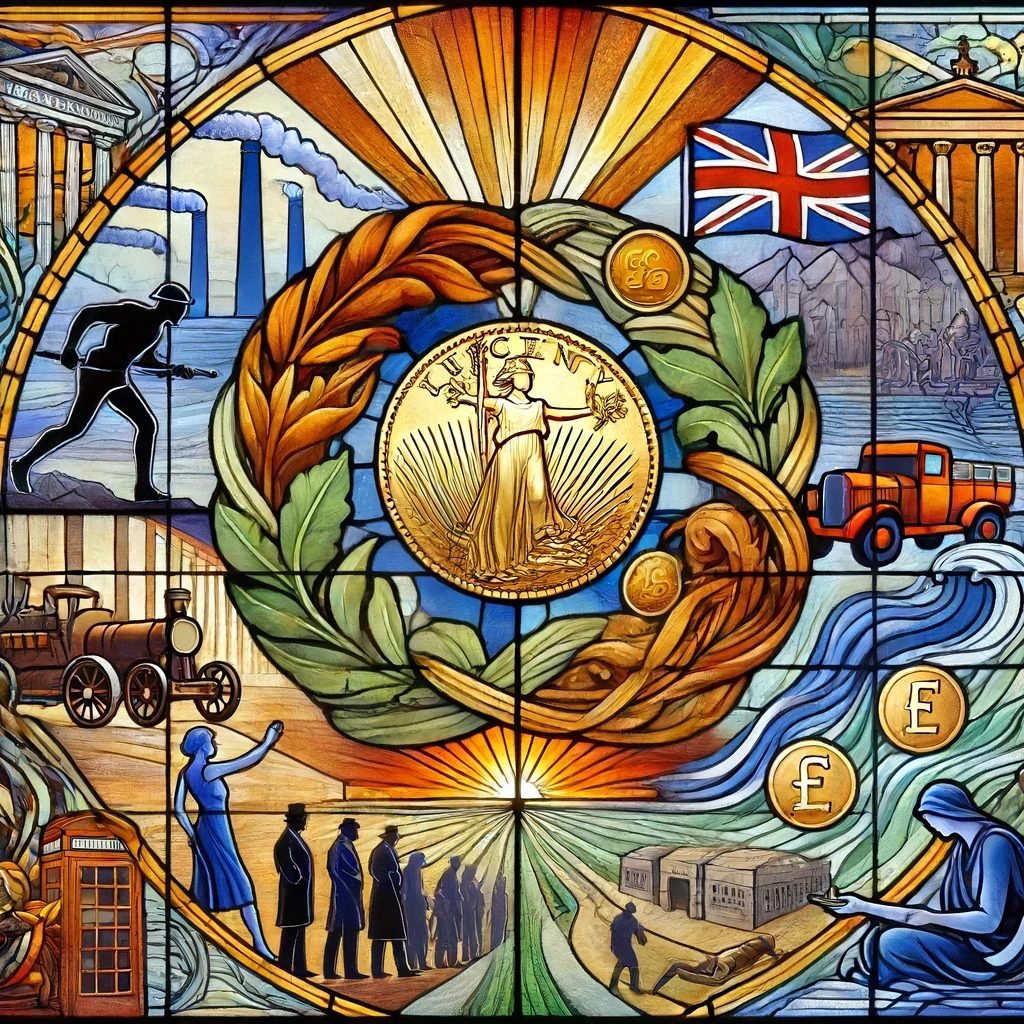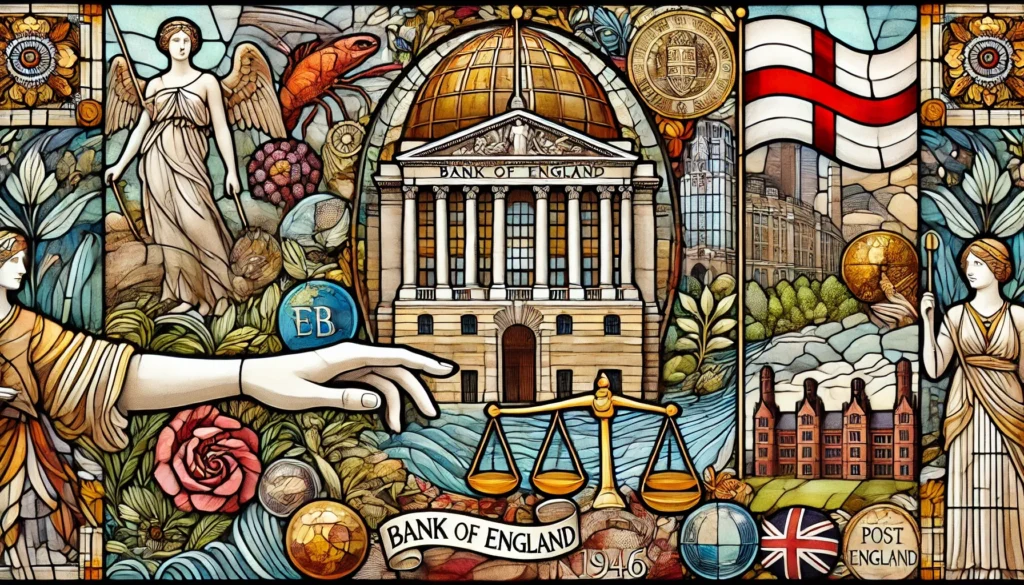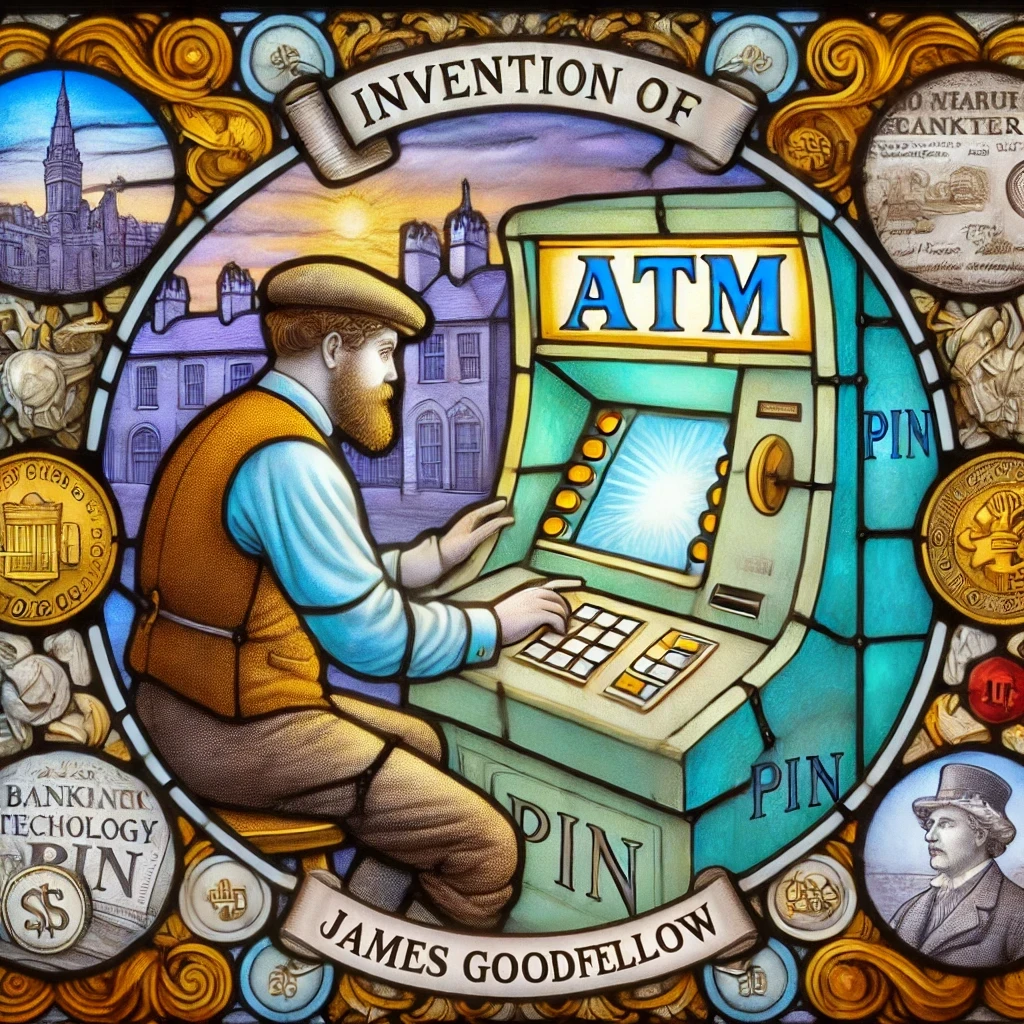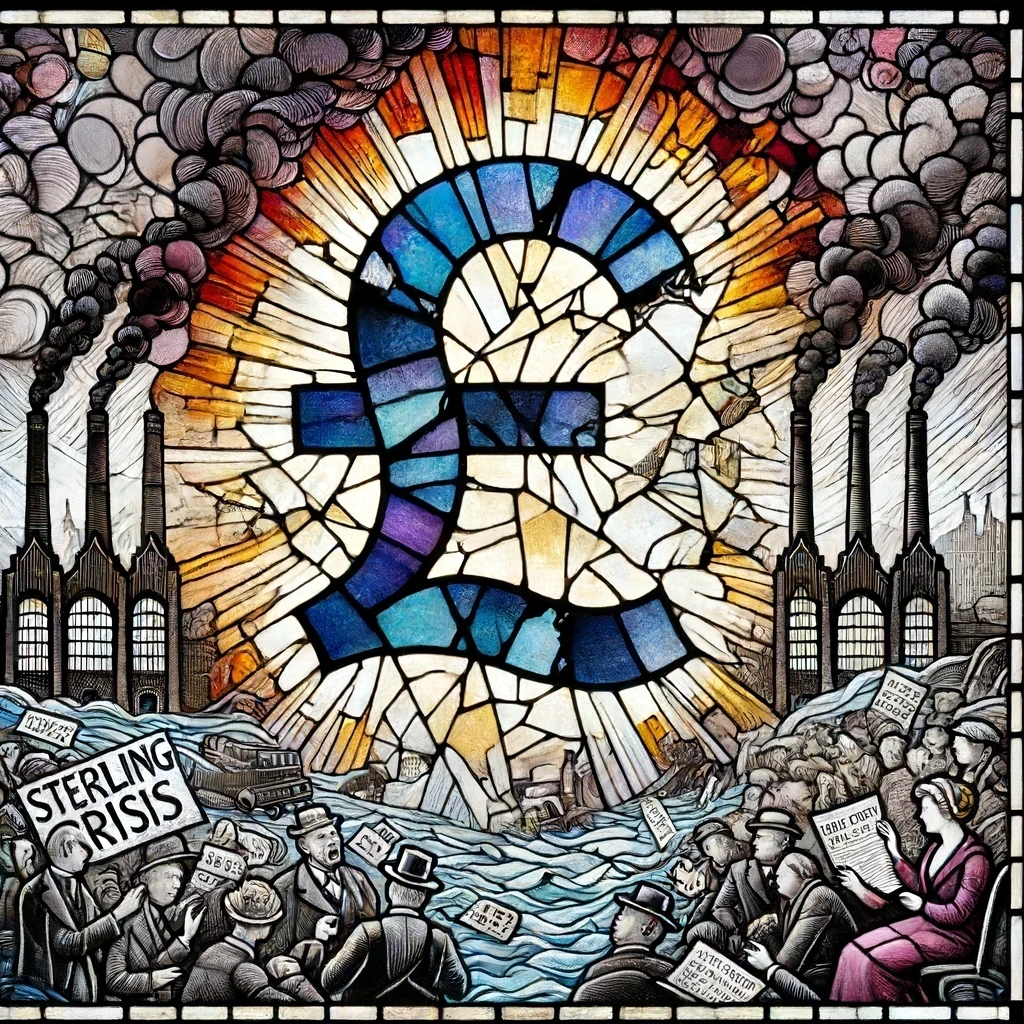1925 – 1967 Mid-20th Century
1925 The Gold Standard Act

The Gold Standard Act of 1925 was a British legislative measure aimed at restoring the pre-World War I gold standard by linking the pound sterling to a fixed amount of gold. Implemented to stabilise the economy, it set the pound’s value at its pre-war parity, resulting in deflationary pressures, reduced export competitiveness, and increased unemployment. Despite criticism from economists like John Maynard Keynes, who warned of its negative effects, the act remained until economic strains from the Great Depression forced the UK to abandon the gold standard in 1931, highlighting the challenges of fixed exchange rates in modern economies.
This digital artwork captures the historical essence of the 1925 Gold Standard Act. Central to the piece is a radiant Britannia, symbolising stability and prosperity, encircled by a laurel wreath. The composition blends warm gold hues with cool blues and greens, balancing wealth and harmony. Key elements like the Union Jack, industrial motifs, and gold coins highlight the era’s technological advancements and economic impact. The queue of figures at the bottom, waiting in line, symbolises the societal anticipation and participation in the economic changes brought by the Act. These figures, alongside various other societal elements, create a compelling and detailed narrative that celebrates this pivotal moment in financial history.
1929 The Great Depression
The Great Depression severely impacted the United Kingdom, leading to a sharp decline in traditional industries, widespread unemployment reaching up to 20%, and significant poverty and social unrest, exemplified by events like the Jarrow March. The financial sector faced challenges, prompting the UK to abandon the Gold Standard in 1931. Politically, the crisis boosted the Labour Party’s influence and led to the formation of a National Government that implemented protective tariffs and public works programs, though these measures were often seen as inadequate. The hardships of the era set the stage for post-World War II welfare state developments and lasting economic reforms.
This digital image offers a poignant depiction of the Great Depression’s impact on the United Kingdom. In landscape format, it seamlessly blends scenes of industrial decline, breadlines, and protests, transitioning to the rise of the Labour Party and government interventions. The dark tones on the left symbolise economic despair, while the lighter hues on the right reflect hope and recovery.

1946 Nationalisation of the Bank of England

The nationalisation of the Bank of England in 1946, executed through the Bank of England Act, transferred ownership from private shareholders to the government, enabling direct control over monetary policy. This move, driven by the post-war Labour government, aimed to enhance economic stability and growth during the post-war recovery by aligning the Bank’s operations with government economic policies. While it improved policy coordination and financial stability, the nationalisation also sparked debates about the potential loss of central bank autonomy and the influence of political factors on monetary decisions. This significant shift laid the groundwork for the eventual operational independence of the Bank in 1997, maintaining its public ownership.
This stained-glass image vividly portrays the 1946 nationalisation of the Bank of England. The central motif features the iconic Bank of England building, surrounded by symbols of government control and economic stability, such as a protective hand and a balanced scale. The background depicts post-war recovery with images of rebuilding and flourishing landscapes. Rich, vibrant hues and intricate patterns characteristic of stained glass art create a cohesive, harmonious flow, making this piece a striking commemoration of a pivotal moment in British economic history.
1948 The Marshall Plan
The Marshall Plan, officially the European Recovery Program, was a U.S. initiative to aid Western Europe’s economic recovery post-World War II, implemented from 1948 to 1952. Announced by Secretary of State George C. Marshall, it provided over $12 billion (~$130 billion today) in grants and loans to rebuild war-torn regions, modernise industry, and counter the spread of Soviet communism. The plan significantly boosted European industrial and agricultural production, promoted political stability, and encouraged economic integration, laying the groundwork for institutions like the European Union. Despite criticisms regarding the exclusion of Eastern Europe and dependency issues, the Marshall Plan is deemed a major success in fostering long-term prosperity and strengthening U.S.-European relations. The United Kingdom received approximately $3.3 billion in aid from the Marshall Plan. This amount was the largest share allocated to any European country and played a crucial role in the UK’s post-war economic recovery, helping to rebuild its infrastructure, stabilise its economy, and modernise its industry.
This exquisite stained glass artwork depicts the Marshall Plan’s impact on post-WWII Europe with a focus on the UK, featuring iconic landmarks like Big Ben and the Union Jack flag. The harmonious composition illustrates the rebuilding of war-torn cities, industrial and agricultural advancements, and symbols of political stability and unity, such as shaking hands and interlinked gears. American aid workers are also shown, emphasising the crucial transatlantic partnership. The vibrant and intricate design blends each element, celebrating the resilience and cooperative spirit that defined Europe’s recovery during this pivotal era.

1966 Invention of ATM and PIN

The invention of the ATM by James Goodfellow in the late 1960s marked a transformative moment in UK history. Goodfellow, a Scottish engineer, patented the Automated Teller Machine, which introduced the concept of convenient, self-service banking to the public. His ATM design incorporated revolutionary features such as the PIN system for secure user authentication, enabling customers to withdraw cash and perform transactions outside of traditional banking hours. This innovation rapidly spread across the UK and globally, reshaping banking practices by reducing the necessity for in-person bank visits and expanding access to financial services. Goodfellow’s ATM not only improved customer convenience but also set a precedent for the development of modern financial technologies, making it a pivotal advancement in the evolution of banking worldwide.
This artwork commemorates the invention of the Automated Teller Machine by Scottish engineer James Goodfellow. It vividly portrays a user interacting with the ATM, highlighting the pioneering PIN technology with the machine’s glowing screen and keypad. The background features banking symbols like coins and banknotes, underscoring the invention’s transformative impact. The vibrant colours and intricate design cast a timeless charm, while prominently displaying Goodfellow’s name in recognition of his contribution.
1967 The Sterling Crisis
The Sterling Crisis of 1967 was a significant economic event in the UK, marked by the devaluation of the British pound by 14.3% against the US dollar due to persistent economic struggles, speculative pressures, and balance of payments deficits. The devaluation aimed to improve export competitiveness but led to immediate inflation and a loss of public confidence in the government’s economic management. Long-term impacts included contributing to the collapse of the Bretton Woods system, prompting stricter economic policies in the UK, and highlighting the need for more flexible exchange rate systems. The crisis ultimately weakened the Labour government’s credibility, influencing its defeat in the 1970 general election.
The artwork captures the essence of the Sterling Crisis. Its central motif, a shattered British pound symbol with jagged edges and falling pieces, symbolises economic turmoil. Surrounding this are scenes depicting industrial decline, a plummeting stock market, public panic outside banks, and headlines announcing devaluation. Dark, sombre colours emphasise the severity, with occasional contrasts highlighting distressing elements. Intricate outlines and vibrant colours typical of stained glass unify the composition. By omitting coins, the artwork focuses on broader economic impacts, enhancing its narrative of widespread financial upheaval centred around the British pound symbol.

